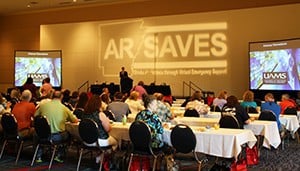Conference Highlights Telemedicine Achievements, Future
May 17, 2013 | As he opened the fourth annual Telestroke Conference on May 14, AR SAVES Director Michael Manley praised the audience for their help in the past year in expanding the program he oversees and gave them a glance at the future of telemedicine in the state. Many of the nearly 200 attendees in the Statehouse Convention Center represented hospitals and clinics throughout the state that take part in the AR SAVES network. Led by the University of Arkansas for Medical Sciences (UAMS), the AR SAVES (Arkansas Stroke Assistance and Virtual Emergency Support) program uses a high-speed video communications system to help provide immediate, life-saving treatments to stroke patients 24 hours a day. The real-time video communication enables a stroke neurologist to evaluate whether emergency room physicians should use a powerful blood-clot busting drug within the critical 4.5-hour period following the first signs of stroke. Manley said the program recently has reached several milestones — treating more than 400 patients with blood-clot busting drugs, approaching nearly 90 percent of the goal of having all Arkansans within 60 minutes of an AR SAVES site, and adding the 41st health care provider to the network. Although the network will continue to add sites in 2013, the program’s focus increasingly will shift from geographic expansion to professional education and making stroke care in Arkansas even better, he said. Telemedicine in general throughout the state will start expanding into entirely new areas — from extending care to jails and prisons to a smartphone and tablet app for reaching hand trauma doctors. “Stroke victims still will be a core part of our program,” Manley said. “We are making a difference with them, but that video cart you have for your ER can be used for more than stroke victims.” He said UAMS is receiving many requests for help via telemedicine connections with mental health care and trauma. Plans are under way to meet that demand as well as to expand into areas of care such as ophthalmology and geriatrics. The completion this summer of the e-Link network will further facilitate those innovations in the future, Manley said. Arkansas e-Link, led by UAMS, is using high-speed data transmission lines to connect 413 community institutions for videoconferencing between medical professionals, patients and doctors and others along with the real-time exchange of patient data and readings. When the rollout is completed, e-Link will have a presence in all 75 Arkansas counties. “At the Arkansas UAMS Center for Distance Health, we wake up every morning, and we truly believe this: ‘Where you live shouldn’t determine whether you live or whether you die,’” Manley said, borrowing a quote from Bono, lead singer of the band U2 and an advocate for public health initiatives in Africa. Following Manley’s opening remarks, Kevin Ryan, J.D., M.A., associate professor and assistant dean for MPH Programs in the UAMS Fay W. Boozman College of Public Health, gave a keynote presentation — “Health Care Reform and Arkansas: 2013 and Beyond.” Ryan said once the federal Affordable Care Act is fully implemented, it is projected to move 328,000 of Arkansas’ 550,000 uninsured to insurance rolls. The expansion will have the added benefit of reducing uncompensated care by as much as $615 million and bringing $478 million in federal funds into the state’s economy that will among other impacts be used to subsidize the purchase of health insurance for those presently uninsured. Health information technology like the technology used in AR SAVES and e-Link also will pay a critical part in reducing costs and improving care in the context of health care reform in the future, Ryan said. Other featured speakers at the conference included Richard Zraick, Ph.D., a professor in the UAMS College of Health Professions Department of Audiology and Speech Pathology; Mary Cantrell, executive director of the UAMS Center for Clinical Skills and Simulation Education; and Delbert McCutchen, R.N., UAMS Center for Distance Health outreach nurse. Closing day sessions of the conference were held on emergency medical sciences, the National Institutes of Health stroke scale and community education. |


